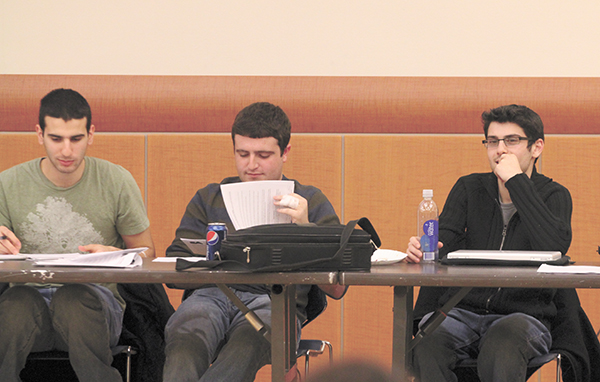
The Binghamton University Student Association unveiled plans Monday night to declare itself independent from the University and to rewrite its constitution in what has been called a once-in-a-lifetime overhaul of the BU student government.
The SA currently exists as a 501(c)(3) not-for-profit organization, but the proposed changes would abolish the current SA and reconstitute it as an incorporated entity.
The change would shift legal liability for the organization from the individual members of the SA Executive Board to the SA as an entity. At present, the SA president and other E-Board members could be held financially responsible for lawsuits against the SA. Incorporation would put legal liability on the organization as a whole.
The leaders of the movement to incorporate also contend that the change would give the SA greater autonomy from the BU administration and would ensure the “long-term viability of the organization” and “solidify [the SA’s] independence” from the University, according to Adam Shamah, the SA’s vice president for finance, who is among the major backers of the change.
The process of incorporation would also go hand-in-hand with an overhaul of the SA’s governmental structure. This is because a corporation must have a board of directors, and there is currently no clear choice for the SA body that would take on that role.
This has led to an effort — headed by SA E-Board members and other select Assembly representatives who were informed of the situation — to rewrite the SA constitution from the ground up.
“We’ve drafted an entirely new constitution,” Shamah said. At the heart of that new constitution is the disbanding of the Assembly, the SA’s current legislative body, in favor of a new body that would act as the SA’s board of directors: the Representative Council.
The Council would have three sub-councils that would oversee specific aspects of student governance. The voting members of the Council would be four members of the SA E-Board, the three chairs of the sub-councils and one popularly-elected at-large representative.
According to Shamah, this marriage of legislative and executive authority would make student government more efficient and create “a more streamlined system.”
But some members of the Assembly, which as a body could face an existential threat, are concerned that such efficiency would come at the cost of checks on the power of government.
Robert Baldwin, chair of the SA’s Student Outreach Committee, said he is generally in favor of incorporating but is concerned that the resulting restructuring of government could interfere with representing students.
“If half of your legislature is your executive branch, then there’s no separation of powers,” Baldwin said.
George Hadjiconstantinou, vice speaker of the Assembly, was also concerned about the implications of the proposals on democratic governance.
“This needs to be a representative democracy, not an oligarchy,” Hadjiconstantinou said. He was concerned that the consolidation of powers created a “mesh” of authorities that may weaken democracy in pursuit of efficiency.
But Assembly Speaker Randal Meyer, who is an advocate for the reformation, said these structural changes are much needed, and that they might not have come about without the push for incorporation.
“We have a clean slate to work from finally,” Meyer said.
SA President Jared Kirschenbaum, who is also backing the changes, said the downsizing of the legislative branch of government would give the average student more “opportunities to voice their opinions and voice their concerns.”
But Baldwin was still concerned about precisely how representative democracy would continue to be carried out.
“As written, it is not democratic, and it is a consolidation of power within the executive branch,” he said. “That doesn’t mean it can’t change dramatically from that before it goes to referendum.” He also said he believed that, with sufficient amendments to the current proposal, the final changes could be “highly beneficial.”
SA Vice President for Academic Affairs Daniel Rabinowitz and Executive Vice President Jenna Goldin unveiled the incorporation and constitutional plans in a PowerPoint presentation to the Assembly Monday night. They called for a timeline that would put the changes to a student body-wide referendum on March 15, just two weeks after the public announcement of the proposals.
Their reasoning was that the vote would have to be held concurrently with the general SA elections, which will also be held March 15, in order to ensure significant voter turnout.
But this has some concerned that this upheaval of the student government is happening too quickly.
“I’d like more time,” Baldwin said.
According to the SA leaders spearheading the change, incorporation has been a goal of the SA for the past 15 to 20 years, but the movement has gathered significant momentum in the past three weeks as the SA has engaged in talks with the BU administration.
Brian Rose, BU vice president for student affairs, has been the University’s major point of contact with the SA in negotiations to move forward with incorporation.
“The Student Association leadership recently informed the University of its desire to pursue a student referendum on possible incorporation of the Student Association,” Rose said. “The University’s interest in the matter is to ensure that all SUNY and Binghamton University policies are followed and to promote a stable student government. We are actively reviewing the matter and are pleased to have an open dialogue with the SA leadership as we do so.”
BU’s SA would not be the first to incorporate among SUNY student governments. The student governments at SUNY Oswego and the University at Albany, as well as the SUNY-wide student government, are already incorporated.


